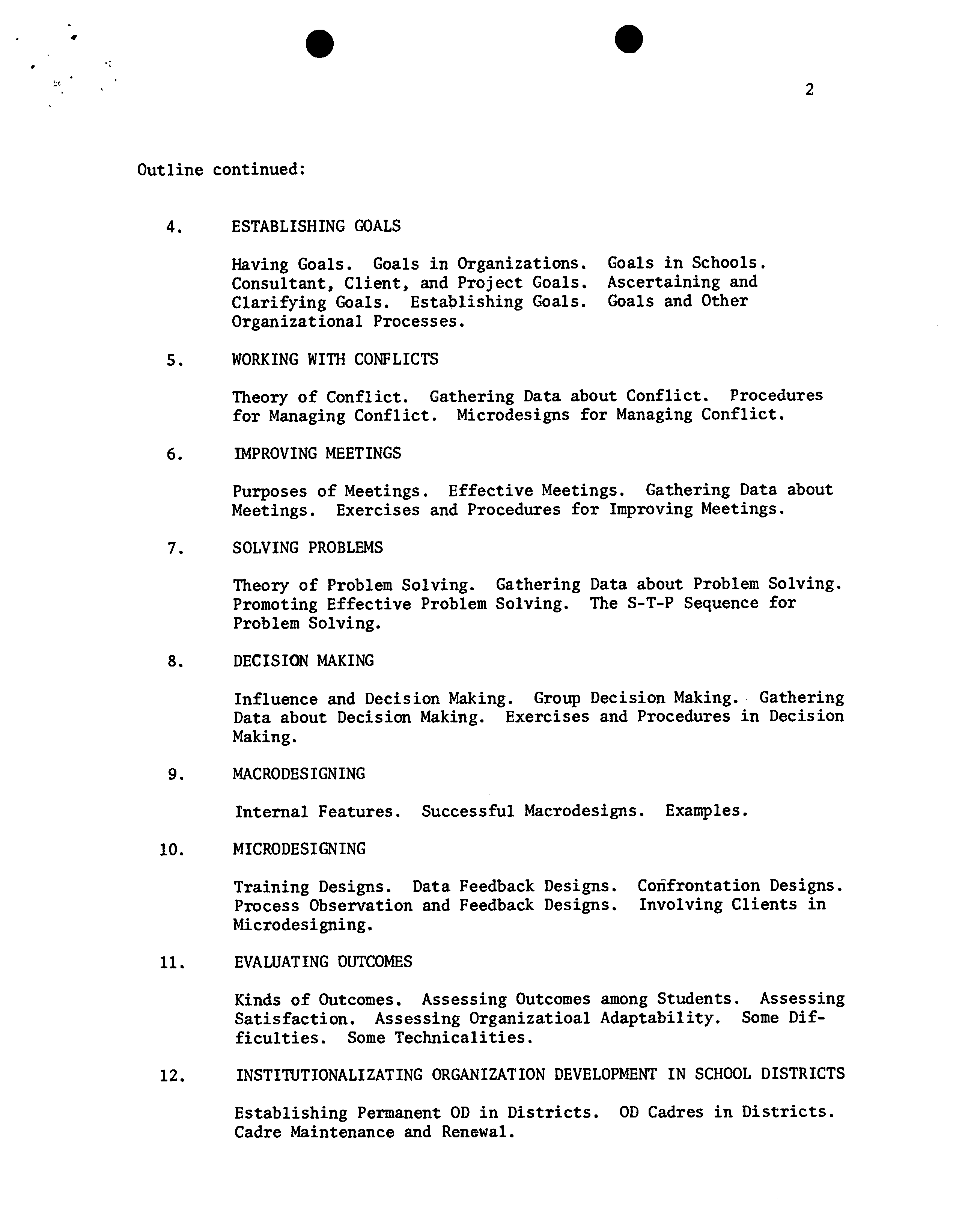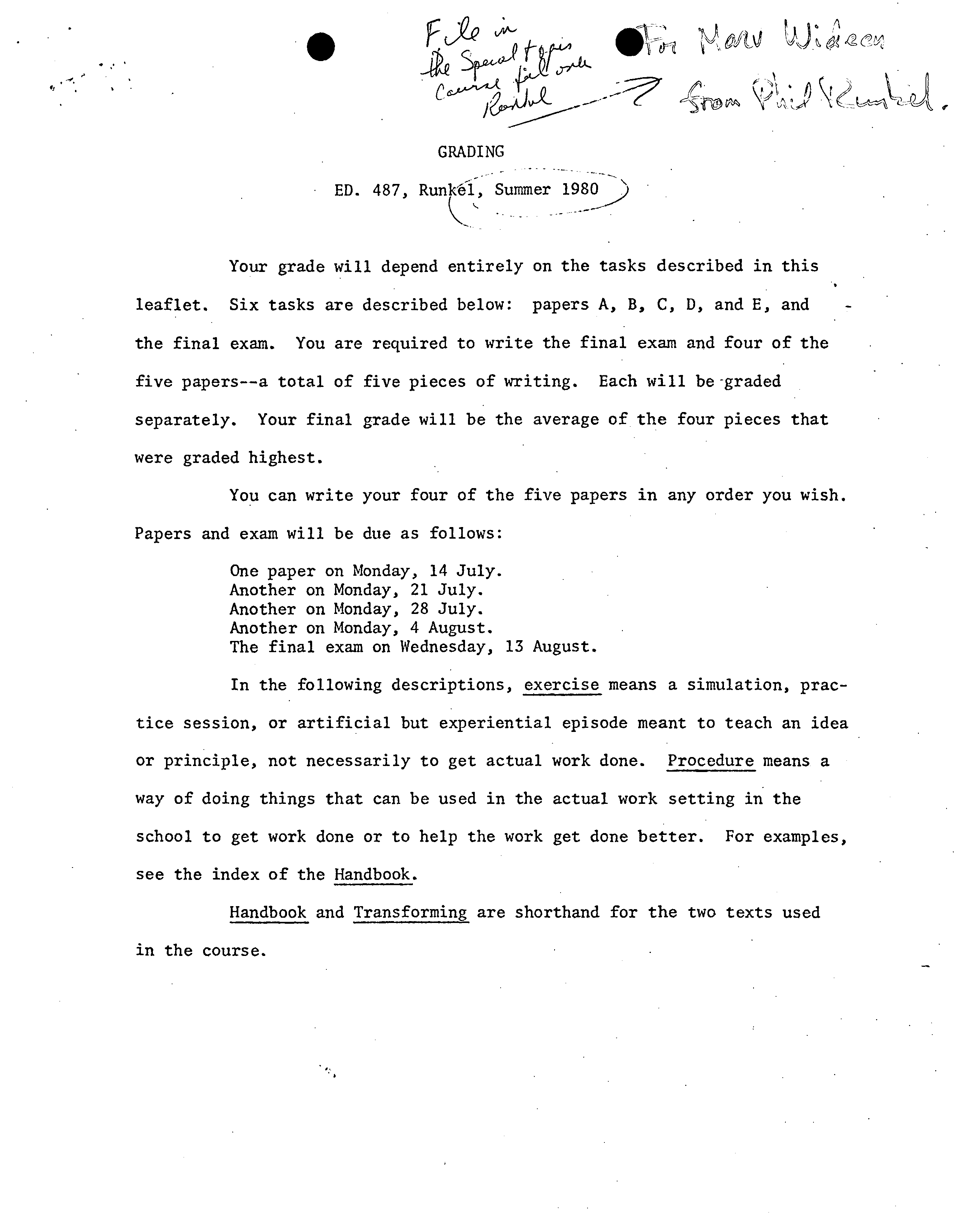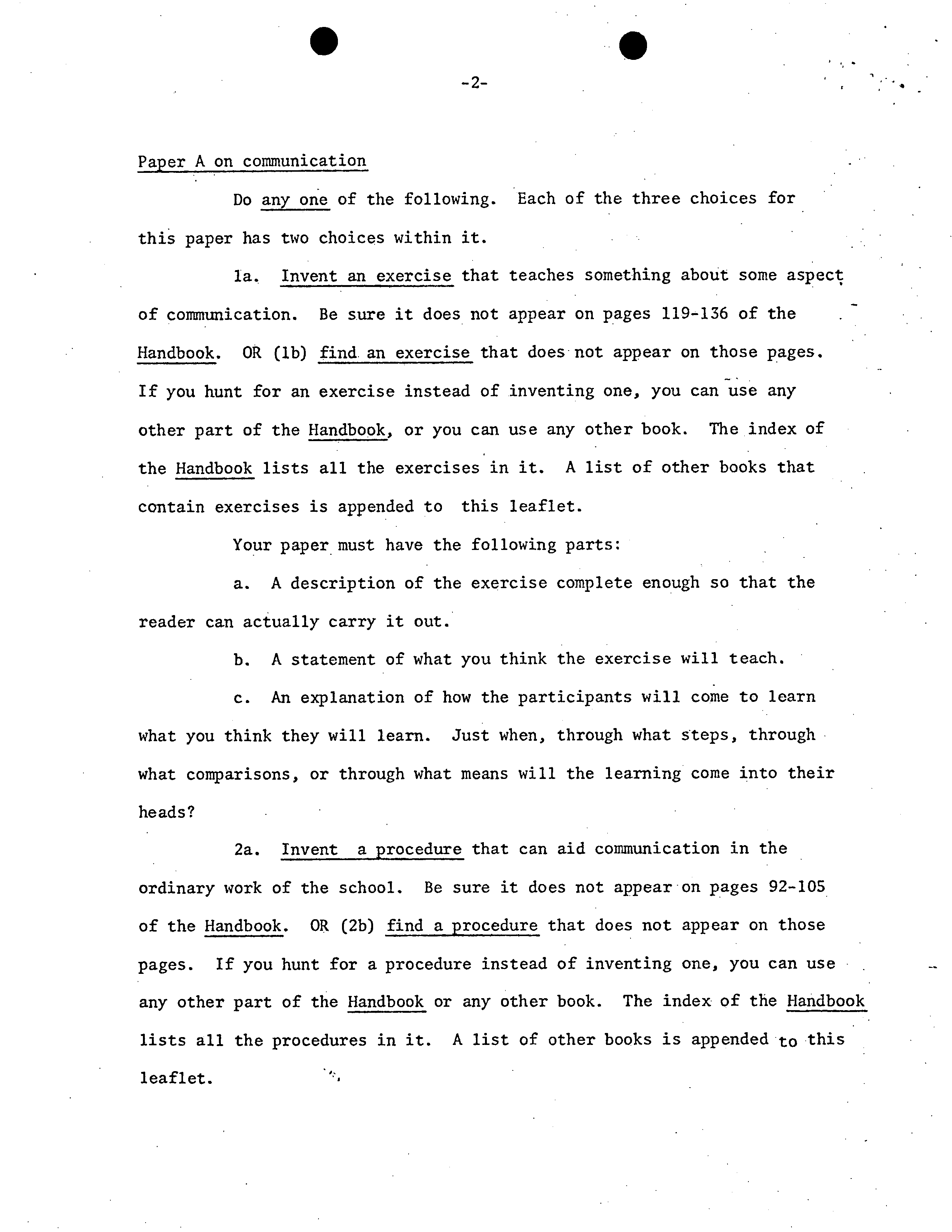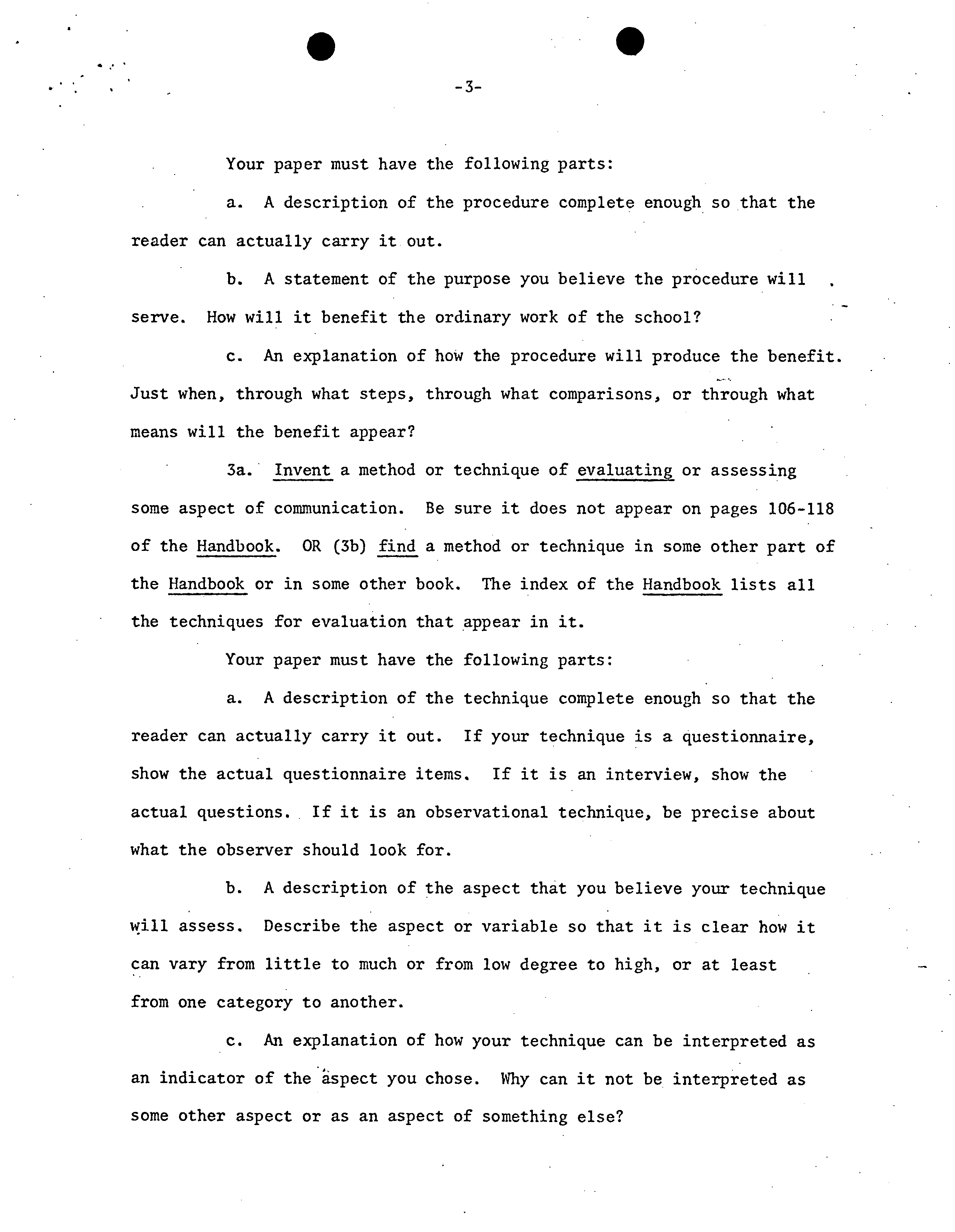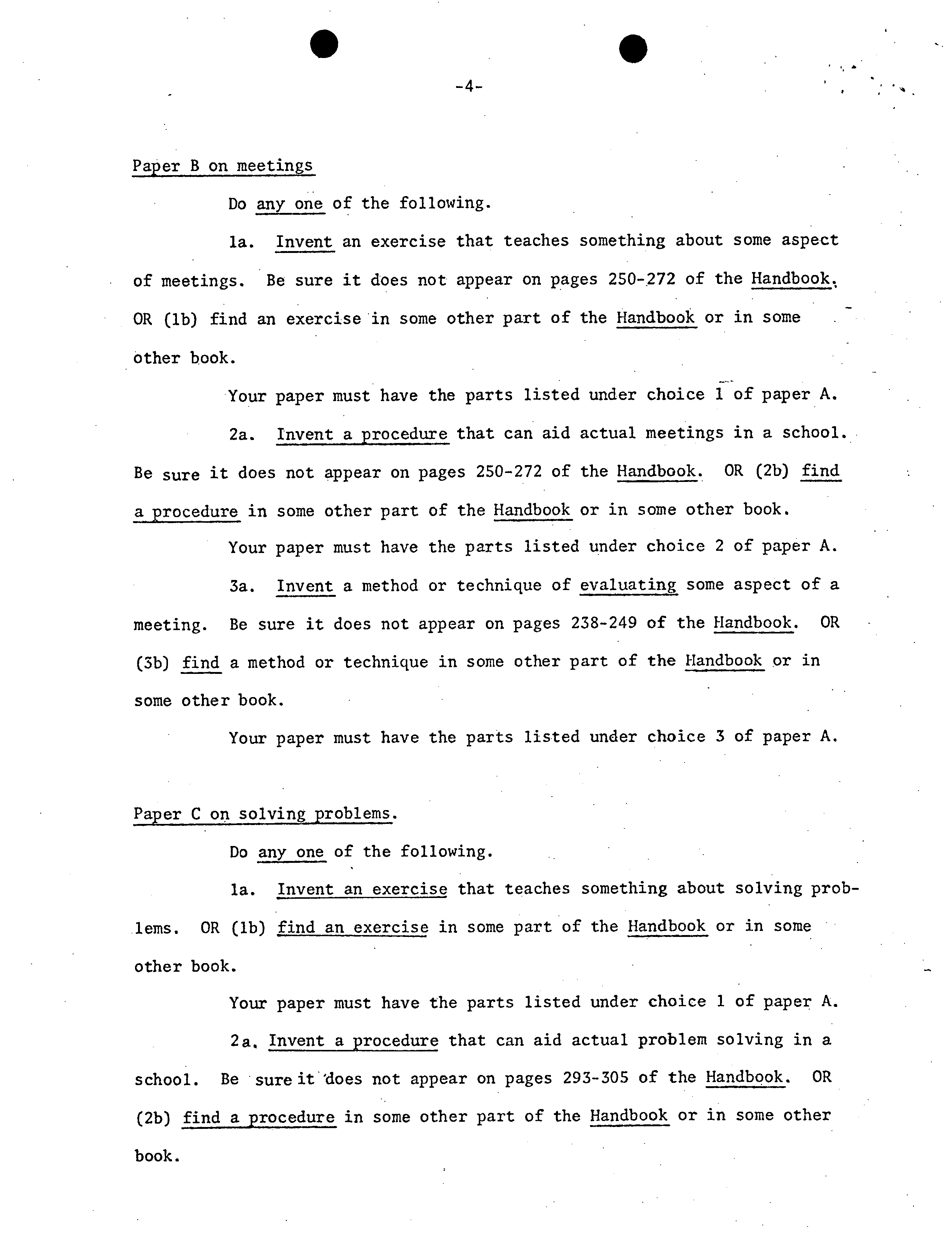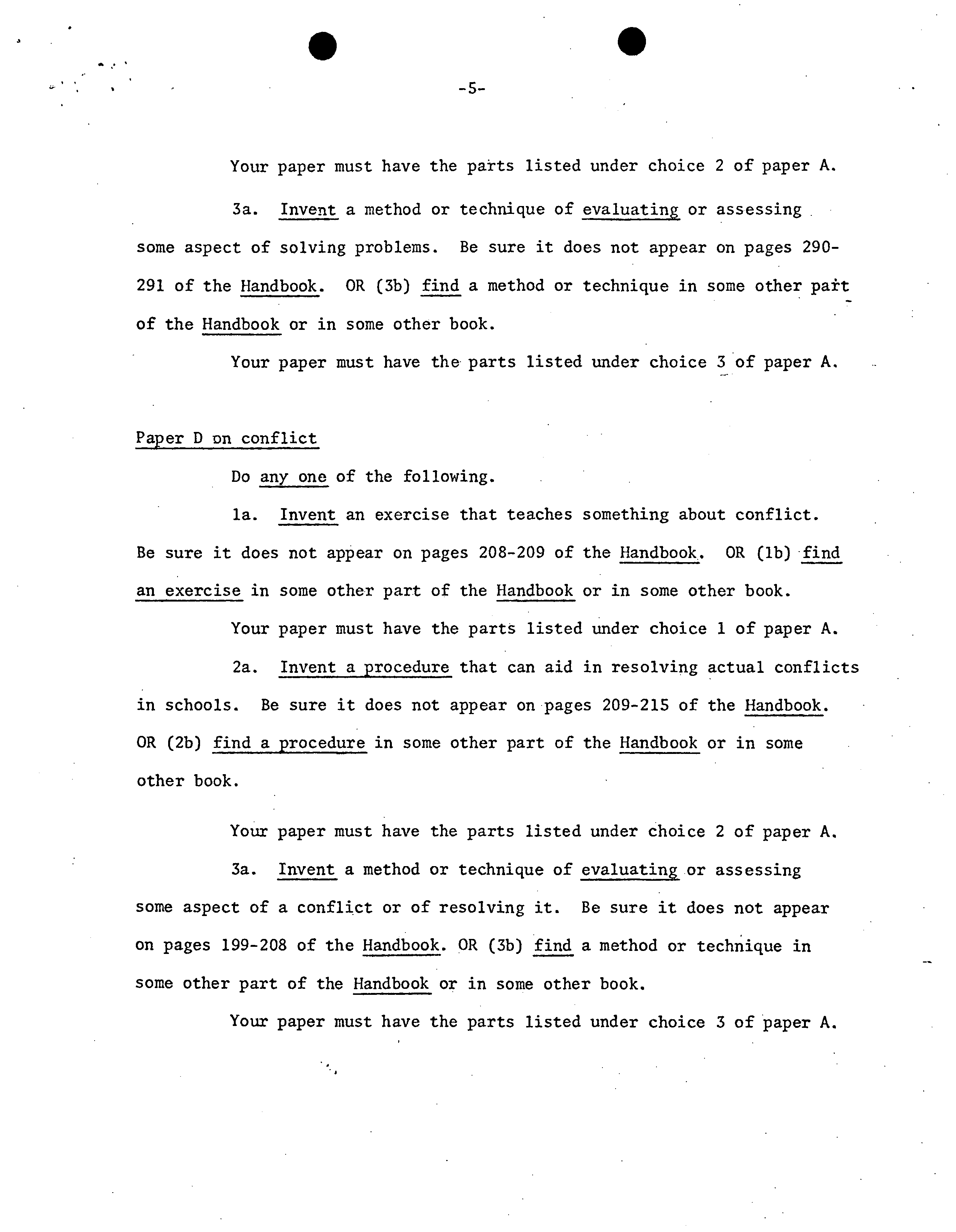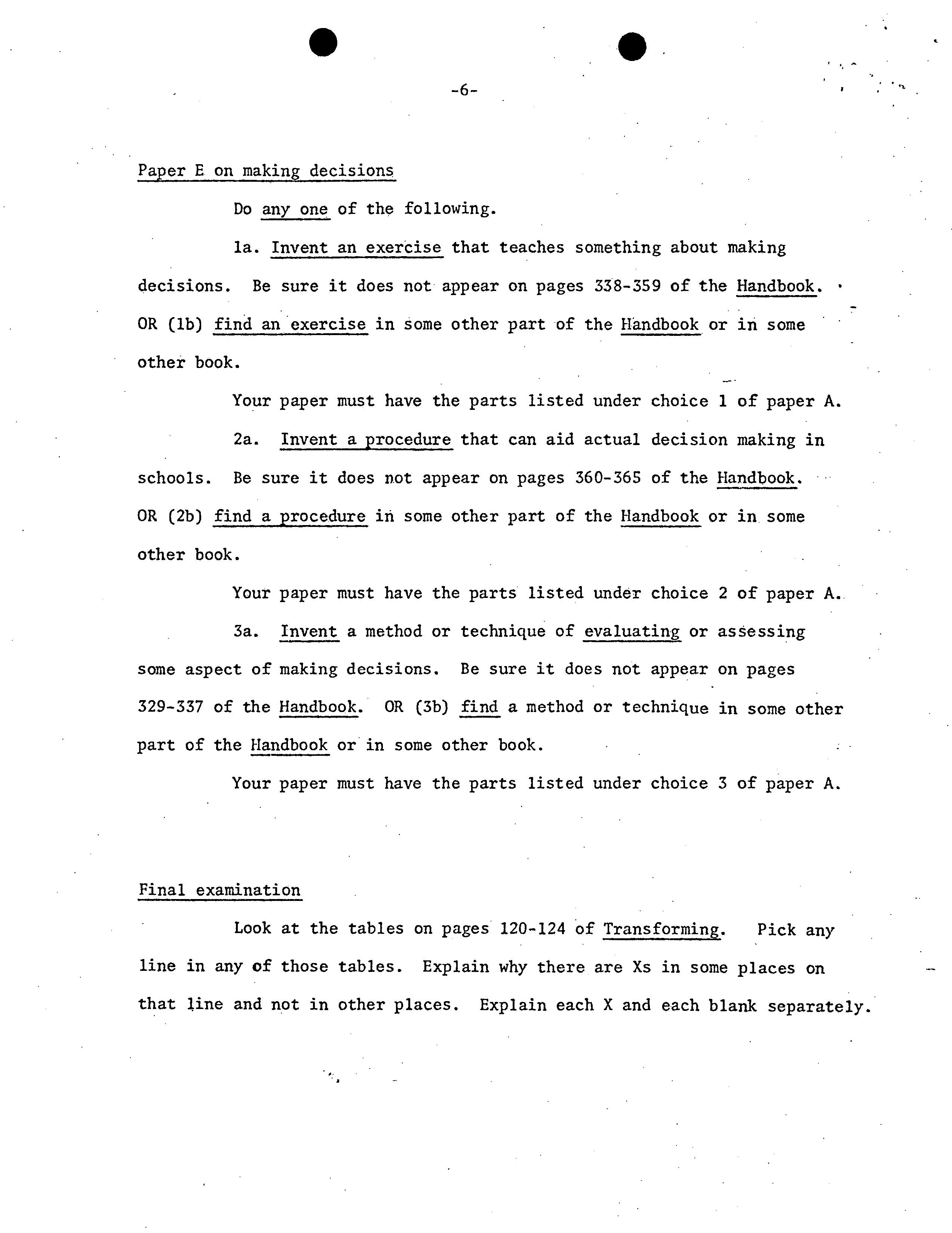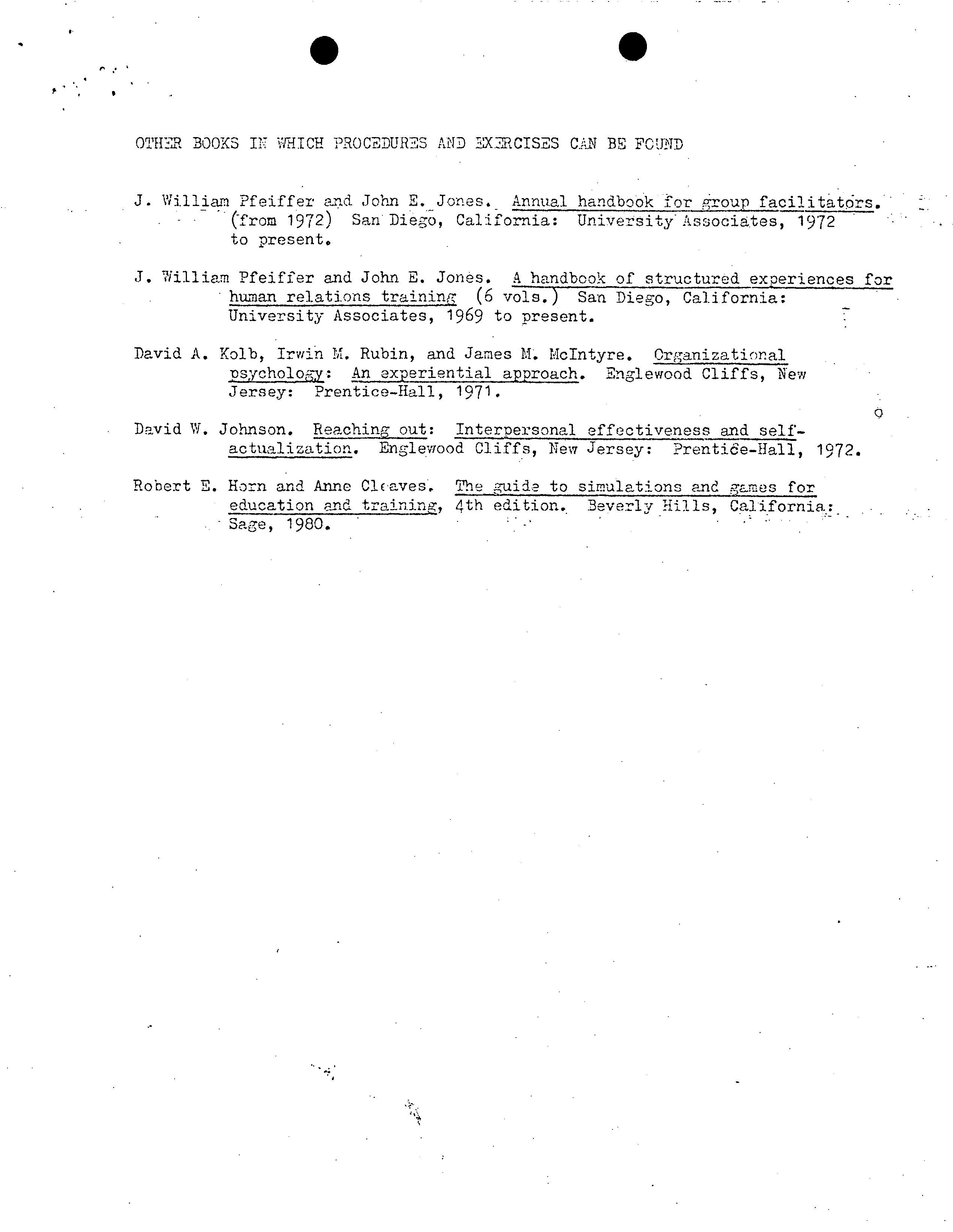.
C, 2.
EDUCATION
487-14
SPECIAL TOPIC: aGANIZATION DEVELOPMENT IN SCHOOLS:
SUMMER SESSION 1980
?
INSTRUCTOR: Philip J. Runkel
Monday & Wednesday,
12:30 -'4:30
Purpose; To acquaint students with the theory and technique of organiza-
tional development and with various applications to organizational life
in schools. Organizational development is a coherent, systematically-
planned, sustained effort at system self-study and improvement, focussing
explicitly on change in formal and informal procedures, processes, norms,
or structures, using behavioral science concepts. The goals of organiza-
tional development include both improving the quality of life of individuals
and improving organizational functioning and performance. Advice will be
included on using consultants; a list of them will be provided.
Methods: Lectures, readings, exercises, simulations, and occasional short
papers. A good part of the time in class will be used for actually ex-
periencing some of the procedures and training exercises used by consultants
in organizational development. Students will not leave the course as com-
petent consultants, but they will have a good understanding of what con-
sultants do and the outcomes to be expected.
Texts: ?
Schmuck, Runkel, Arends, and Arends. Second Handbook of Organiza-
tional Development in Schools. Palo Alto, California: Mayfield,
1977.
Runkel, Schmuck, Arends, and Francisco. Transforming the School's
Capacity for Problem Solving. Eugene, Oregon: Center for
Educational Policy
and Mana
g
ement. 1979.
Outline:
1.
THEORY AND TECHNOLOGY
What is Organization Development? A Theory for Organization
Development in Schools. Types of Intervention. Processes of
Training and Consultation.
2.
DIAGNOSIS
Information Gathering. Context, Design, Progress, Outcome.
Diagnostic Information.
3.
CLARIFYING COMMUNICATION
Types of Communication. Interpersonal Communication. Communi-
cation in the Subsystem. Organization-wide Communication.
Gathering Data about Communication. Exercises and Designs.
. ?
.
2
Outline continued:
4.
?
ESTABLISHING GOALS
Having Goals. Goals in Organizations. Goals in Schools.
Consultant, Client, and Project Goals. Ascertaining and
Clarifying Goals. Establishing Goals. Goals and Other
Organizational Processes.
S.
?
WORKING WITH CONFLICTS
Theory of Conflict. Gathering Data about Conflict. Procedures
for Managing Conflict. Microdesigns for Managing Conflict.
6.
IMPROVING MEETINGS
Purposes of Meetings. Effective Meetings. Gathering Data about
Meetings. Exercises and Procedures for Improving Meetings.
7.
SOLVING PROBLEMS
Theory of Problem Solving. Gathering Data about Problem Solving.
Promoting Effective Problem Solving. The S-T-P Sequence for
Problem Solving.
8.
DECISION MAKING
Influence and Decision Making. Group Decision Making. Gathering
Data about Decision Making. Exercises and Procedures in Decision
Making.
9.
MACRODESIGNING
Internal Features. Successful Macrodesigns. Examples.
10.
MICRODESIGNING
Training Designs. Data Feedback Designs. Confrontation Designs.
Process Observation and Feedback Designs. Involving Clients in
Microdesigning.
11.
EVALUATING OUTCOMES
Kinds of Outcomes. Assessing Outcomes among Students. Assessing
Satisfaction. Assessing Organizatioal Adaptability. Some Dif-
ficulties. Some Technicalities.
12.
INSTI11JTIONALIZATING ORGANIZATION DEVELOPMENT IN SCHOOL DISTRICTS
Establishing Permanent OD in Districts. OD Cadres in Districts.
Cadre Maintenance and Renewal.
•,., ?
•;
?
vwkv
S
GRADING
ED. 487, Runkel, Summer 1980 .
Your grade will depend entirely on the tasks described in this
leaflet. Six tasks are described below: papers A, B, C, D, and E, and
the final exam.
You
are required to write the final exam and four of the
five papers--a total of five pieces of writing. Each will be graded
separately. Your final grade will be the average of the four pieces that
were graded highest.
You can write your four of the five papers in any order you wish.
Papers and exam will be due as follows:
One paper on Monday, 14 July.
Another on Monday, 21 July.
Another on Monday, 28 July.
Another on Monday, 4 August.
The final exam on Wednesday, 13 August.
In the following descriptions, exercise means a simulation, prac-
tice session, or artificial but experiential episode meant to teach an idea
or principle, not necessarily to get actual work done. Procedure means a
way of doing things that can be used in the actual work setting in the
school to get work done or to help the work get done better. For examples,
see the index of the Handbook.
Handbook and Transforming are shorthand for the two texts used
in the course.
.
?
.
-2-
Paper A on communication
Do any one of the following. Each of the three choices for
this paper has two choices within it.
Ia. Invent an exercise that teaches something about some aspect
of communication. Be sure it does not appear on pages 119-136 of the
Handbook. OR (lb) find, an exercise that does not appear on those pages.
If you hunt for an exercise instead of inventing one, you can use any
other part of the Handbook, or
you
can use any other book. The index of
the Handbook lists all the exercises in it. A list of other books that
contain exercises is appended to this leaflet.
Your paper must have the following parts:
a.
A description of the exercise complete enough so that the
reader can actually carry it out.
b.
A statement of what you think the exercise will teach.
c.
An explanation of how the participants will come to learn
what you think they will learn. Just when, through what steps, through
what comparisons, or through what means will the learning come into their
heads?
2a. Invent a procedure that can aid communication in the
ordinary work of the school. Be sure it does not appear on pages 92-105
of the Handbook. OR (2b) find a procedure that does not appear on those
pages. If you hunt for a procedure instead of inventing one, you can use
any other part of the Handbook or any other book. The index of the Handbook
lists all the procedures in it. A list of other books is appended
to
this
leaflet.
S ?
S
-
?
-.3-
Your paper must have the following parts:
a.
A description of the procedure complete enough so that the
reader can actually carry it out.
b.
A statement of the purpose you believe the procedure will
serve. How will it benefit the ordinary work of the school?
c. An explanation of how the procedure will produce the benefit.
Just when, through what steps, through what comparisons, or through what
means will the benefit appear?
3a. Invent a method or technique of evaluating or assessing
some aspect of communication. Be sure it does not appear on pages 106-118
of the Handbook. OR (3b) find a method or technique in some other part of
the Handbook or in some other book. The index of the Handbook lists all
the techniques for evaluation that appear in it.
Your paper must have the following parts:
a.
A description of the technique complete enough so that the
reader can actually carry it out. If your technique is a questionnaire,
show the actual questionnaire items. If it is an interview, show the
actual questions. If it is an observational technique, be precise about
what the observer should look for.
b.
A description of the aspect that you believe your technique
will assess. Describe the aspect or variable so that it is clear how it
can vary from little to much or from low degree to high, or at least
from one category to another.
c.
An explanation of how your technique can be interpreted as
an indicator of the .spect you chose. Why can it not be interpreted as
some other aspect or as an aspect of something else?
. ?
.
-
? -4-
Paper B on meetings
Do any one of the following.
Ia. Invent an exercise that teaches something about some aspect
of meetings. Be sure it does not appear on pages 250-272 of the Handbook.
OR (lb) find an exercise in some other part of the Handbook or in some
other book.
Your paper must have the parts listed under choice lof paper A.
2a. Invent a procedure that can aid actual meetings in a school.
Be
sure
it does not appear on pages 250-272 of the Handbook. OR (2b) find
a procedure in some other part of the Handbook or in some other book.
Your paper must have the parts listed under choice 2 of paper A.
3a. Invent a method or technique of evaluating some aspect of a
meeting. Be sure it does not appear on pages 238-249 of the Handbook. OR
(3b) find a method or technique in some other part of the Handbook or in
some other book.
Your paper must have the parts listed under choice 3 of paper A.
Paper C on solving problems.
Do any one of the following.
Ia. Invent an exercise that teaches something about solving prob-
lems. OR (lb) find an exercise in some part of the Handbook or in some
other book.
Your paper must have the parts listed under choice 1 of paper A.
2a. Invent a procedure that can aid actual problem solving in a
school. Be sure itdoes not appear on pages 293-305 of the Handbook. OR
(2b) find a procedure in some other part of the Handbook or in some other
book.
.
-5-
Your paper must have the parts listed under choice 2 of paper A.
3a. Invent a method or technique of evaluating or assessing
some aspect of solving problems. Be sure it does not appear on pages 290-
291 of the Handbook. OR (3b) find a method or technique in some other pa±t
of the Handbook or in some other book.
Your paper must have the parts listed under choice 3 of paper A.
Paper D on conflict
Do any one of the following.
la. Invent an exercise that teaches something about conflict.
Be sure it does not appear on pages 208-209 of the Handbook . . OR (lb) find
an exercise in some other part of the Handbook or in some other book.
Your paper must have the parts listed under choice 1 of paper A.
2a. Invent a procedure that can aid in resolving actual conflicts
in schools. Be sure it does not appear on pages 209-215 of the Handbook.
OR (2b) find a procedure in some other part of the Handbook or in some
other book.
Your paper must have the parts listed under choice 2 of paper A.
3a. Invent a method or technique of evaluating or assessing
some aspect of a conflict or of resolving it. Be sure it does not appear
on pages 199-208 of the Handbook. OR (3b) find a method or technique in
some other part of the Handbook or in some other book.
Your paper must have the parts listed under choice 3 of paper A.
.
?
..
-6-
Paper B on making decisions
Do any one of the following.
Ia. Invent an exercise that teaches something about making
decisions. Be sure it does not appear on pages 338-359 of the Handbook.
OR (lb) find an exercise in some other part of the Handbook or in some
other book.
Your paper must have the parts listed under choice 1 of paper A.
2a. Invent a procedure that can aid actual decision making in
schools. Be sure it does not appear on pages 360-365 of the Handbook.
OR (2b) find a procedure in some other part of the Handbook or in some
other book.
Your paper must have the parts listed under choice 2 of paper A.
3a. Invent a method or technique of evaluating or assessing
some aspect of making decisions. Be sure it does not appear on pages
329-337 of the Handbook. OR (3b) find a method or technique in some other
part of the Handbook or in some other book.
?
-
Your paper must have the parts listed under choice 3 of paper A.
Final examination
Look at the tables on pages 120-124 of Transforming.
?
Pick any
?
line in any of those tables. Explain why there are Xs in some places on
that line and not in other places. Explain each X and each blank separately.
. ?
.
0THE2 BOOKS I1T VHICH PROCEDURES AND EXCISES CAI'J BE FOUND
J. William ?feiffer and John E. Jones. Annual handbook for _oup facilita
'to'rs.
-
(from
1972)San
Diego, California: University'Assocites,
1972
to present,
J. William Pfeiffer and John E. Jones. A handbook of structured exDeriences for
human relations traininir (6 vols.) San Diego, California:
University Associates,
1969
to present.
David A. Kolb, Irwin M. Rubin, and James M. McIntyre. Organizational
psychol2a _-
Afl
experiential approach. Englewoad Cliffs, New
Jersey: Prentice-Hall,
1971.
David W. Johnson. Reaching out: Interpersonal effectiveness and
self-
actualization. Englewood Cliffs, New Jersey: ?rentie-Hall,
1972.
Robert B. Horn and Anne Cl'aves. The guide to simulations and games for
education and train4, 4th edition. Beverly Hills, California.:
- Sage, 1980.
w.


